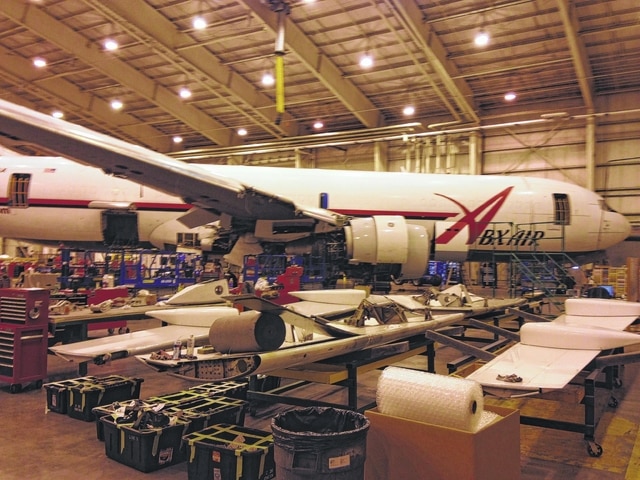

WILMINGTON — AMES executives say a proposed corrosion and materials study could provide the airline industry with repairs of billions of dollars’ worth of parts that would otherwise be thrown away.
The project, funding for which is identified in Ohio’s biennial budget, would partner Airborne Maintenance & Engineering Services with the University of Akron College of Engineering’s Corrosion Engineering program.
Together, the two would develop technology that would replace corroded material on airplanes.
“This technology is intended to replace corroded material by applying a high pressure powder that is made of the same type of material at a very high pressure, and it will allow us to potentially save parts from being thrown away,” said AMES President Brady Templeton. “If proven, then it could really create a lot of opportunities for us,” other companies and further military application.
AMES and UA must prove to the Federal Aviation Administration that the repaired parts are airworthy.
“The university brings the analysis of the restoration,” Templeton said. “Also, what they provide are the individuals that have the ability to certify that from a regulatory standpoint.”
AMES Director of Business Operations Brad Heath, the first step would be to remove the corroded material by use of a “blender,” then to spray the same-material powder onto the affected area.
“You’re literally spraying the metal powder in layers to build back up the area that was damaged,” Heath said.
Heath said the process was called “supersonic particle deposition,” and referred to as “cold spray” because it doesn’t require heating or melting any material. A robotic arm would apply the spray within in a secure booth area.
From there, the surface can be repaired like normal.
“It is a project to commercialize a technology that’s really been developed in the military and the academic environment,” Heath said.
Heath said the project is a natural fit for both UA and AMES and a good way of partnering Ohio industries with Ohio universities.
“They’re sort of experts in this whole area of corrosion, so it’s a nice fit,” he said. “They’re an Ohio based institution, and we’re an Ohio based business that deals with corrosion everyday.”
And, benefits, like job creation, can come about if the project succeeds.
“If this technology proves viable, and we can overcome glitches, it gives us a competitive advantage, it allows us to support our component repair business, and ultimately … it does play into jobs in that the more competitive AMES is and the more successful we are, that all strengthens our business.”
Heath also said the ability to repair corrosive materials could give AMES an edge in securing clients.
“We have parts everyday out here that we end up replacing on airplanes due to corrosion that can cost anywhere from $1,000 to $50,000 … for a single part,” Heath said. “Corrosion is a huge problem across the entire industry. … It’s in the billions of dollars a year that’s spent replacing corroded parts just in the United States.”
Heath said the funding would foster a series of meetings and help create a plan “to build the application capability here in Wilmington.”
Reach Nathan Kraatz at 937-382-2574, ext. 2510 or on Twitter @NathanKraatz.

